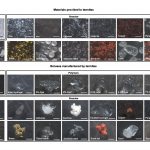Termites build mounds from anything they can chew and move on
Bower bird nests, bee hives and towering termite mounds have always fascinated architects, naturalists and laypersons alike but we barely know how they are built. A study by an interdisciplinary team consisting Nikita Zachariah (a PhD student) and Prof. Renee M Borges from the Centre for Ecological Sciences, Aritra Das from the Centre for NeuroScience and Prof. Tejas G Murthy from the Department of Civil Engineering, IISc offers interesting clues on how termites build huge mounds.
 Researchers explored the bricks used in termite mound onstruction and the choice of materials for this construction. They offered termites a range of materials such as soil, glass beads, metal powders, wax, jellies and even tissue paper. To their surprise they found that termites used all the materials as long as they were able to walk and chew on them.
Researchers explored the bricks used in termite mound onstruction and the choice of materials for this construction. They offered termites a range of materials such as soil, glass beads, metal powders, wax, jellies and even tissue paper. To their surprise they found that termites used all the materials as long as they were able to walk and chew on them.
Termites do had their personal favourites, e.g. they loved granular materials over others and were equally willing to use non-familiar materials like glass beads as the familiar ones (soil). Moreover, different castes of termites (such as major and minor termites) made different sizes of bricks which they jointly packed like golf balls in a jar with marbles filling the space between the balls thereby achieving tight packing and consequently high strength.
This work takes us towards understanding how tiny termites without an architect can build structures that can withstand rain and heat for many decades.
This article was featured in Science magazine:
http://www.sciencemag.org/news/2017/07/these-termites-can-use-glass-beads-build-mounds
Referrence: http://www.nature.com/articles/s41598-017-04295-3
website : http://ces.iisc.ac.in/renee/main.html ; http://civil.iisc.ac.in/~tejas/
Other Featured research




 Researchers explored the bricks used in termite mound onstruction and the choice of materials for this construction. They offered termites a range of materials such as soil, glass beads, metal powders, wax, jellies and even tissue paper. To their surprise they found that termites used all the materials as long as they were able to walk and chew on them.
Researchers explored the bricks used in termite mound onstruction and the choice of materials for this construction. They offered termites a range of materials such as soil, glass beads, metal powders, wax, jellies and even tissue paper. To their surprise they found that termites used all the materials as long as they were able to walk and chew on them.